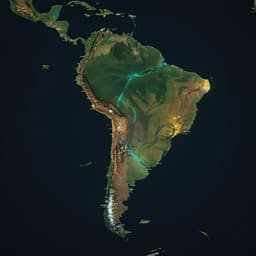
Earth Sciences
Niche-dependent forest and savanna fragmentation in Tropical South America during the Last Glacial Maximum
D. I. Kelley, H. Sato, et al.
This groundbreaking research by Douglas I. Kelley and colleagues uncovers the fragmented landscapes of the Amazon during the Last Glacial Maximum, challenging established theories on biodiversity and refugia. Discover how drier ecosystems might have shaped a unique corridor for species diversification while connecting isolated forest fragments.
~3 min • Beginner • English
Introduction
The long-standing debate over the drivers of Amazonian biodiversity centers on whether glacial periods fragmented the rainforest into refugia or whether forests remained largely stable. Haffer’s refugia hypothesis posits that cooler, drier glacial climates fractured closed-canopy moist forests into isolated refugia separated by savannas, reducing gene flow and promoting diversification, with reconnection during interglacials. Counterevidence from palaeoecological and genetic data has questioned both the pattern and timing of habitat change, prompting alternative explanations such as riverine barriers driving vicariance. Early climate modeling suggested a largely stable LGM rainforest with limited border savannafication, but these studies lacked key processes (low CO₂ effects, climate–fire interactions) critical for forest–savanna transitions. The present study aims to rigorously test the existence and configuration of forest fragments and savanna connectivity during the LGM by directly integrating palynological data into dynamic vegetation model outputs, assessing fragmentation, corridor formation, and the niche conditions that may have maintained connectivity between vegetation types.
Literature Review
Palynological evidence for LGM Amazonian stability is inconclusive due to sparse, margin-skewed sampling. Earlier modeling indicated stable rainforest with limited savannafication, but omitted pivotal processes such as CO₂ deprivation and fire. Sato et al. (2021) reconciled sparse pollen data with DVM outputs and showed that glacial aridity, low CO₂, and altered fire regimes likely drove widespread savannafication and partial forest fragmentation, supporting central and circum-Amazonian savanna corridors (with a hypothesized coastal corridor also discussed). Despite improved agreement with pollen, discrepancies remained where models simulated forests but pollen indicated savanna, motivating direct bias-correction. The broader literature also posits riverine barriers as diversification drivers and discusses historical linkages among Amazonia, Cerrado, and Atlantic Forest, with mixed phylogeographic signals for savanna and forest taxa regarding past connectivity.
Methodology
- Modeling framework: Used LPX dynamic global vegetation model (fire-enabled; low CO₂ impacts) driven by LGM climates from four GCMs (CNRM, FGOALS, HadGEM, MIROC) and an ensemble reconstruction formed by averaging bioclimatic outputs across the four. Model outputs included growing degree days (GDD > 5°C), fractional projected cover (FPC), vegetation height, and fractional cover of evergreen/deciduous and tropical/temperate PFTs.
- Biomisation: Adapted schemes from Prentice and Ciais to translate model bioclimatic outputs into biomes. Forests and savannas were defined as FPC > 0.6; savannas additionally had height < 10 m. Introduced a new ecotone class: woodland/tall savanna (FPC > 0.6, height 5–10 m) to resolve forest–savanna boundaries. Forest and savanna subtypes further partitioned by GDD, phenology, and tropical vs. temperate composition. Thresholds were adjusted to enable quantitative comparison to pollen-derived biomes.
- Bias-correction with pollen: Compiled 42 pollen-core sites (Marchant et al.) and mapped their biome assignments to bioclimatic ranges for six variables (FPC, evergreen fraction, tropical fraction, temperate fraction, height, GDD). Transformed variables (logit for fractions and height relative to a 130 m limit; log for GDD) to approximate normality. For each site and variable, computed the distance to the closest boundary of the observed biome range. Interpolated these differences using thin plate splines (fields::Tps in R) to produce spatial bias-correction surfaces, then corrected LPX outputs accordingly. Performed sensitivity tests varying the FPC (0.2–0.75) and height thresholds (2.5–20 m) to assess robustness.
- Clustering: Applied k-means clustering (unsupervised) to bias-corrected height and FPC to identify bioclimatically similar regions and more objective boundaries than expert-set thresholds. Mapped clusters to infer connectivity and transition zones.
- Benchmarking: Quantified model skill using the Discrete Manhattan Metric (DMM) comparing simulated vs. observed biomes at pollen sites. Ensemble achieved DMM = 0.117 (vs. null all-forest 0.235 and all-savanna 0.229), indicating ~49% improvement over best null; individual GCM runs improved by 32–41%.
- Fragmentation assessment: Converted biome maps (forest vs. other; savanna vs. other) into polygons to enumerate total fragments, major fragments (≥10% of largest polygon), and percent area outside the largest fragment. Conducted analyses both with woodland/tall savanna grouped with savanna and with forest.
- Data and code: Pre/post bias-corrected datasets available on Zenodo; LPX code and bias-correction scripts available via Zenodo/GitHub.
Key Findings
- Bias-corrected reconstructions indicate a savanna-driven opening of three corridors: circum-Amazonian along the Andes, a central Amazonian corridor, and a Northeast coastal corridor. Short savannas (<5 m) formed northern and southern fragments, but were linked by woodland/tall savanna (FPC > 0.6, height 5–10 m), which connected otherwise disjoint savanna and forest regions.
- Forest fragmentation: Bias-corrected ensemble suggests at least 5 major tropical humid forest fragments, with the largest in moist western Amazonia, a second in central Amazonia, and a third along the Andes; 24 smaller forest patches also occur, predominantly in central/southern Amazonia. In the bias-corrected map (with woodland/tall savanna grouped with savanna), 52.63% of forest area lies outside the main fragment vs. 17.36% uncorrected. When woodland/tall savanna is grouped with forest, major forest fragments reduce to 1 and only 14.53% of forest area lies outside the largest fragment.
- Area and fragmentation metrics (Fig. 3):
• Forest area (million km²): uncorrected 5.51 (savanna grouping) / 7.22 (forest grouping); corrected 2.07 (savanna grouping) / 5.28 (forest grouping). Major forest fragments: uncorrected 1; corrected 5 (savanna grouping) or 1 (forest grouping). Total forest fragments: uncorrected 50–61; corrected 29 (savanna grouping) or 50 (forest grouping).
• Savanna area (million km²): uncorrected 6.39 (savanna grouping) / 4.59 (forest grouping); corrected 10.6 (savanna grouping) / 7.16 (forest grouping). Major savanna fragments: uncorrected 2–4; corrected 1 (savanna grouping) or 2 (forest grouping). Fragmentation index: uncorrected 1.79–2.36; corrected 1.23 (savanna grouping) or 2.2 (forest grouping).
- Model uncertainty: All GCM-driven bias-corrected simulations showed substantially more savanna than uncorrected (e.g., 5.51–7.06 vs. 2.07–3.54 million km² forest area, indicating savannafication), with a central dry corridor emerging in all corrected runs but only partially in some uncorrected runs. HadGEM2 suggested a possible nearly continuous western forest; MIROC yielded two major short-savanna fragments.
- Drivers of change: Bias correction primarily altered vegetation height and, to a lesser extent, FPC. Height increased in the western core (denser forests) and decreased elsewhere, shaping forest fragments and their woodland/tall savanna boundaries.
- Clustering (k-means on height and FPC) identified four broad types: Tall Dense Forest; Dense forests/thickets; taller, sparse semi-arid formations; and short, sparse desert/shrubs. A connected dense-vegetation cluster spanned Amazonia, but with embedded corridors and patches of more open vegetation. Fragmentation metrics (Fig. 5): Tall Dense Forest area 0.6 million km² (1 major fragment; 8 total; 18.70% outside largest), Sparse forest/woodland 5.01 (1; 86; 10.71%), Grassland/savanna 5.09 (2; 135; 72.38%), Barren 10.71 (8; 93; 21.26%). Approximately 18.7% of humid forests lie outside the main connected dense-vegetation fragment.
- Refugia context: Reconstructed western Amazonian forest refugia approximate Haffer’s predictions (including near Inambari and possible overlap with Rondônia), but exact locations and numbers differ. Crucially, woodland/tall savanna connected many forest patches, suggesting ‘semi-refugia’ linked by ecotonal corridors rather than isolated islands in an open savanna matrix.
Discussion
Directly incorporating pollen constraints into DVM outputs reveals a mosaic of LGM vegetation with both fragmentation and connectivity. While humid forests were broken into multiple fragments consistent with a refugial signal, broad tracts of woodland/tall savanna connected these fragments and linked northern and southern savannas, forming corridors across Amazonia. This ecotone likely facilitated range expansion and gene flow for generalist forest and savanna species during glacial periods, while simultaneously posing barriers for habitat specialists, potentially promoting diversification. The clustering analysis, independent of subjective biome thresholds, corroborates the presence of connected dense-vegetation regions interrupted by more open, semi-arid patches, aligning with proposed central and circum-Amazonian corridors. Differences from Haffer’s classic refugia (in number, size, and connectivity) are expected given uncertainties in climate simulations, vegetation modeling, pollen reconstructions, and the qualitative nature of original refugia maps. The inferred semi-refugia and corridor dynamics also align with observed weak genetic structure across many taxa within interfluvials and with mixed phylogeographic signals in savanna species. Additionally, historical expansions of white-sand ecosystems in northern/central/coastal regions likely added complexity to regional land-cover patterns, further influencing connectivity and diversification pathways.
Conclusion
By fusing palynological observations with dynamic vegetation modeling through statistical bias-correction, this study reconstructs an LGM Amazonia characterized by niche-dependent fragmentation: multiple forest fragments embedded within and connected by extensive woodland/tall savanna ecotones. These connections likely established dispersal corridors for generalists while maintaining partial isolation for specialists, reconciling elements of both refugia and corridor hypotheses. The approach demonstrates that integrating proxy data directly into model fields refines reconstructions of past vegetation and connectivity, yielding testable biogeographic predictions. Future work should expand and better distribute pollen sampling in humid cores, refine biomisation thresholds and bias-correction frameworks, incorporate additional bioclimatic and disturbance variables, and explore modern analogs of reconstructed woodland/tall savanna to validate species–habitat associations and dispersal dynamics.
Limitations
- Spatial bias in proxy data: Pollen cores are sparse and concentrated near Amazonian margins, with few sites in the humid central basin. Bias-correction is more reliable near these sites and less certain in data-poor regions (e.g., central Amazon).
- Model and climate uncertainties: Differences among GCM-driven reconstructions indicate sensitivity to paleoclimate inputs. Vegetation model assumptions (fire, CO₂ effects) also affect outcomes.
- Threshold and variable choices: Biomisation and woodland/tall savanna definitions rely on thresholds; although sensitivity tests were performed, results still depend on these choices. Clustering used only height and FPC, which may not capture all relevant niche dimensions.
- Refugia correspondence: Reconstructed refugia do not perfectly match historical hypotheses, reflecting uncertainties in both the original qualitative maps and the modeling–proxy framework.
- Potential lack of modern analogs: Some reconstructed vegetation combinations may lack clear present-day equivalents, complicating direct validation.
Related Publications
Explore these studies to deepen your understanding of the subject.







